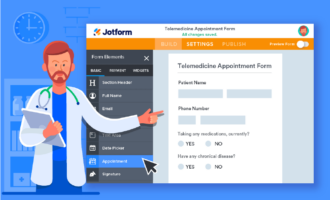Do you know how your patients feel about your medical practice? Do they feel like they’re getting the best care possible? If you don’t know the answers to these questions, you’re missing out on a crucial opportunity to improve your practice. Find out what your patients think by using patient satisfaction surveys.
Patient satisfaction surveys are a great way to gather feedback and create a plan to make changes so you can better meet patients’ needs and continually improve your practice. These types of surveys show that there’s often room for improvement.
Just so you know
You’ve got your medical toolkit ready to help those in need — but what about your telemedicine toolkit? With Jotform’s HIPAA-friendly telehealth platform, you can easily create online medical forms that keep sensitive health data safe.
Providers know how important the patient experience is to their practice; 75 percent say it’s critical for survival. But a whopping 81 percent of consumers say they’re unsatisfied with their healthcare experience. That’s why patient satisfaction surveys are so important.
To get quantifiable results, ask patients to rate their satisfaction on a scale of one to five, with one indicating “poor” and five “excellent.” This will give you a consistent way to compare and analyze the data. Make sure the questions you ask are easy to understand and stated in a way that will solicit feedback that can help you improve your patient care.
Below are five patient satisfaction survey questions to get you started.
5 patient satisfaction survey questions
- How easy was it for you to schedule an appointment?
- How would you rate your wait to see a provider?
- Were you satisfied with your interactions with the doctor and office staff?
- How was the overall care you received?
- How likely would you be to recommend our medical practice to your friends and family?
1. How easy was it for you to schedule an appointment?
Patients are busy — and many times sick or injured — when they contact you. If they can’t easily schedule an appointment with your practice, they’re going to get frustrated and go somewhere else. Healthcare has to be accessible to be effective, and the first key to providing satisfactory care is to give patients an easy way to schedule an appointment.
While they should be able to phone the facility, many patients want to book an appointment online and outside of traditional business hours. In fact, 77 percent of patients think that having the ability to book, cancel, or change appointments online is important.
To make sure you’re meeting their needs, ensure that you have a way for patients to schedule an appointment through your website. Also, ensure that the process is as easy as possible. Be sure to ask about the ease of booking appointments online and how the process could be improved. If you receive a lot of complaints, you’ll know you need to reevaluate your scheduling process.
2. How would you rate your wait to see a provider?
Nobody likes to be kept waiting, and patients are no exception. If they’re left in the waiting room too long, that will negatively impact your patient satisfaction scores. While some wait time is almost inevitable, it’s important to ask your patients about their experience and how long they waited. They need to know that you value their time.
If patients consistently have to wait more than 20 minutes past the time they’ve scheduled for appointments, you should consider scheduling fewer appointments with more time allotted for each patient or looking for inefficiencies to keep appointments moving as scheduled.
3. Were you satisfied with your interactions with the doctor and office staff?
Quality customer service is key to patient satisfaction, so be sure to ask patients if they were treated kindly and with respect, not just by the doctors and nurses but also the office staff.
Asking them to rate this aspect of your practice can provide insight into how well your staff is handling customer service. Be sure to leave room for them to explain their rating on this particular question, as patients may want to commend a specific employee for their actions or discuss a difficult encounter.
4. How was the overall care you received?
This is an important question to include because it encompasses the whole visit — from making an appointment and waiting to be seen to the interactions with the staff — and gives you an overall view of the quality of care that you provided. If patients are regularly giving you low ratings for overall care, you’ll need to figure out where those problems are and take action to resolve them.
5. How likely would you be to recommend our medical practice to your friends and family?
A great way to grow your patient base is to give such great care that your patients want to refer friends and family to you. But if existing patients indicate that they aren’t satisfied with their overall experience at your practice, they’re not going to refer you, and in fact, might do just the opposite.
If a majority of survey respondents indicate they would refer a family member or friend to you, you’re probably providing them with care that’s on par or better than their expectations.
Just so you know
If your organization is fighting against COVID-19, you can apply for a free, unlimited, HIPAA-friendly Jotform account with our Coronavirus Responder Program.
Administering patient satisfaction surveys
Now that you have your patient satisfaction survey questions, how do you administer the survey itself? While you can always distribute paper copies in the office or via mail, this isn’t very efficient.
You can administer an electronic survey anytime. Patients can complete these surveys via a mobile device, on their laptop or desktop, and on computers in waiting rooms. In addition to gathering valuable feedback to improve your practice, you’ll also be able to collect patient information for treatment purposes.
Regardless of how you administer the survey, make sure you’re able to analyze the responses so that you can truly take to heart the opinions of your patients and continually improve your practice — and their experience.

















































Send Comment: